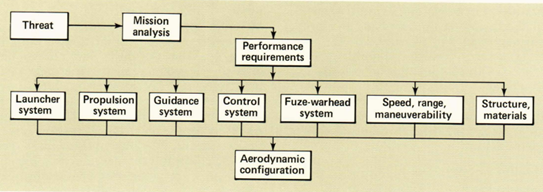Reading Activity
The goal is to discover how to develop a tactical missile system either to counter an expected threat to one's own defended area (a defensive system) or to destroy or do significant damage to the enemy's defended area (an offensive system). This means designing the external configuration of the airframe so as to provide sufficient capability (speed, range, and manoeuvrability) to accomplish the mission planned for the system.
The aerodynamicist must carry out his preliminary design study while recognizing the limitations on his options that are imposed by necessary choices in the other technologies or subsystems, as indicated in Figure 1 and discussed in the next section. The mission analysis should lead to design goals for range, speed, and manoeuvrability of the missile, fuzing and warhead needs, and an overall guidance philosophy. At this stage, first-cut individual choices can be made by the several related technologies to achieve the mission. Modifications to those choices will be made as more-detailed interrelated studies of subsystem performance are made. Thus, a baseline configuration can be established from which further development can proceed.

Fig. 1 Factors and systems affecting the design of aerodynamic configurations
Launching
Besides restricting the missile's weight, length, and span, the launching system may restrict its permissible motion early in flight. Also, such factors as the motion of the launcher and winds or extraneous flow fields about it will affect the missile's design. The aerodynamic design must be done with full knowledge of these considerations so that detrimental effects can be minimized.
Propulsion
A missile's shape may depend strongly on its propulsion system. Designers of air breathing systems prefer to locate the air inlets in areas free of degrading aerodynamic interference such as shock waves, vortices, or wakes. At the same time, the inlet itself may degrade the aerodynamic performance. Thus, a compromise must be made between propulsion performance and aerodynamic performance, or, if possible, a design should be sought that takes advantage of favourable interactions that improve thrust, lift, stability, and controllability or that reduces drag.
Guidance
The choice of guidance system will affect the demands on missile manoeuvrability and response, which, in turn, may affect the choice of lifting and control surfaces. Furthermore, the design of domes to protect guidance sensors usually calls for compromises.
Warhead and Fuze
The demands of the warhead and fuzing on the aerodynamic performance occur primarily during the brief interval prior to target engagement when the missile should be placed in a position and an attitude that will maximize the kill by the warhead. The other subsystems (guidance, control, propulsion) must work in concert with the airframe to provide this favorable condition.
Autopilot and Control
Three aerodynamic control systems use all-movable control surfaces: canard controls located well forward on the missile, tail controls located well aft, and wing controls located near the midbody.
The main task is to assess the threat and, on the basis of feasible battle scenarios, develop a missile system concept to counter it.